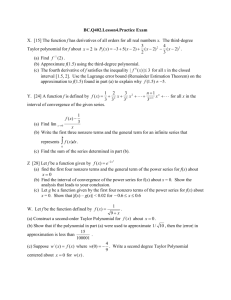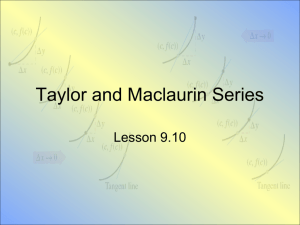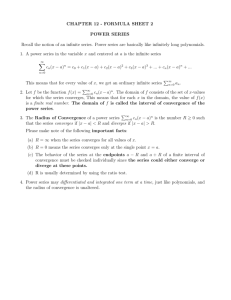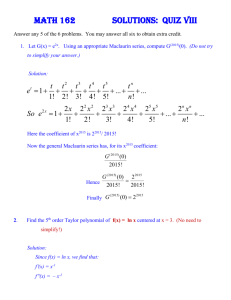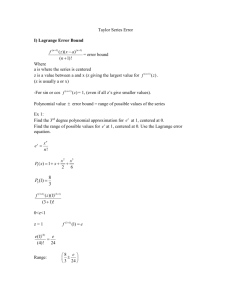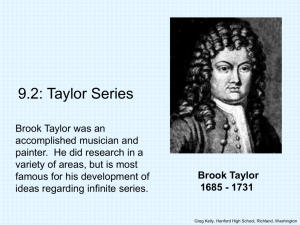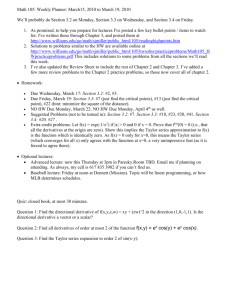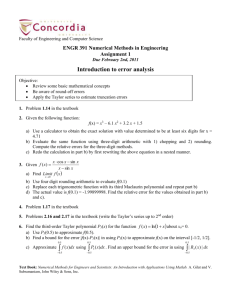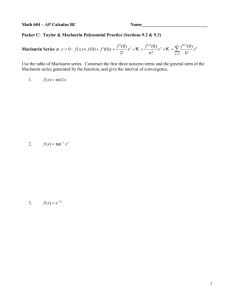power series
advertisement
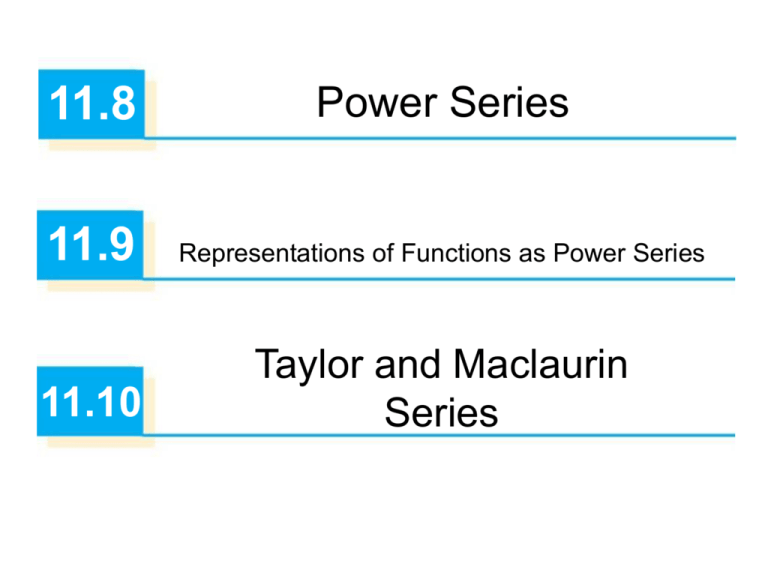
11.8 Power Series 11.9 Representations of Functions as Power Series 11.10 Taylor and Maclaurin Series Power Series A power series is a series of the form where x is a variable and the cn’s are constants called the coefficients of the series. A power series may converge for some values of x and diverge for other values of x. 2 Power Series The sum of the series is a function f(x) = c0 + c1x + c2x2 + . . . + cnxn + . . . whose domain is the set of all x for which the series converges. Notice that f resembles a polynomial. The only difference is that f has infinitely many terms. Note: if we take cn = 1 for all n, the power series becomes the geometric series xn = 1 + x + x2 + . . . + xn + . . . which converges when –1 < x < 1 and diverges when | x | 1. 3 Power Series More generally, a series of the form is called a power series in (x – a) or a power series centered at a or a power series about a. 4 Power Series We will see that the main use of a power series is that it provides a way to represent some of the most important functions that arise in mathematics, physics, and chemistry. Example: the sum of the power series, , is called a Bessel function. Many applications, mainly in: - EM waves in cylindrical waveguide, heat conduction Electronic and signal processing Modes of vibration of artificial membranes, Acoustics. 5 Power Series The first few partial sums are Graph of the Bessel function: 6 Power Series: convergence The number R in case (iii) is called the radius of convergence of the power series. This means: the radius of convergence is R = 0 in case (i) and R = in case (ii). 7 Power Series The interval of convergence of a power series is the interval that consists of all values of x for which the series converges. In case (i) the interval consists of just a single point a. In case (ii) the interval is ( , ). In case (iii) note that the inequality |x – a| < R can be rewritten as a – R < x < a + R. 8 Representations of Functions as Power Series We start with an equation that we have seen before: We have obtained this equation by observing that the series is a geometric series with a = 1 and r = x. But here our point of view is different. We now regard Equation 1 as expressing the function f(x) = 1/(1 – x) as a sum of a power series. 9 Approximating Functions with Polynomials 10 Example: Approximation of sin(x) near x = a (3rd order) (1st order) (5th order) 11 12 Brook Taylor was an accomplished musician and painter. He did research in a variety of areas, but is most famous for his development of ideas regarding infinite series. Brook Taylor 1685 - 1731 13 Greg Kelly, Hanford High School, Richland, Washington Practice: Suppose we wanted to find a fourth degree polynomial of the form: P x a0 a1 x a2 x2 a3 x3 a4 x 4 that approximates the behavior of f x ln x 1 at x 0 If we make P 0 f 0, and the first, second, third and fourth derivatives the same, then we would have a pretty good approximation. 14 P x a0 a1 x a2 x2 a3 x3 a4 x 4 f x ln x 1 f x ln x 1 P x a0 a1 x a2 x2 a3 x3 a4 x 4 f 0 ln 1 0 P 0 a0 P x a1 2a2 x 3a3 x2 4a4 x3 1 f x 1 x 1 f 0 1 1 f x a0 0 P 0 a1 1 1 x 1 f 0 1 1 2 a1 1 P x 2a2 6a3 x 12a4 x2 P 0 2a2 1 a2 2 15 P x a0 a1 x a2 x2 a3 x3 a4 x 4 f x P x 2a2 6a3 x 12a4 x2 1 1 x 2 P 0 2a2 1 f 0 1 1 f x 2 3 P 0 6a3 f 0 2 f 4 f x 6 4 1 1 x 0 6 1 a2 2 P x 6a3 24a4 x 1 1 x f x ln x 1 4 P P 4 4 2 a3 6 x 24a4 0 24a4 6 a4 24 16 P x a0 a1 x a2 x2 a3 x3 a4 x 4 f x ln x 1 1 2 2 3 6 4 P x 0 1x x x x 2 6 24 x 2 x3 x 4 P x 0 x 2 3 4 If we plot both functions, we see that near zero the functions match very well! 5 4 3 f x 1 1 2 3 4 5 -2 -5 -1 -0.5 0 0.5 1 -0.5 -3 -4 1 0.5 2 -5 -4 -3 -2 -1 0 -1 f x ln x 1 P x -1 17 Our polynomial: 0 1x 1 2 2 3 6 4 x x x 2 6 24 has the form: f 0 2 f 0 3 f 4 0 4 f 0 f 0 x x x x 2 6 24 or: f 0 f 0 f 0 2 f 0 3 f 4 0 4 x x x x 0! 1! 2! 3! 4! This pattern occurs no matter what the original function was! 18 Definition: Taylor Series: (generated by f at x a ) f a f a 2 3 P x f a f a x a x a x a 2! 3! If we want to center the series (and it’s graph) at zero, we get the Maclaurin Series: Maclaurin Series: (generated by f at x 0 ) f 0 2 f 0 3 P x f 0 f 0 x x x 2! 3! 19 Exercise 1: find the Taylor polynomial approximation at 0 (Maclaurin series) for: y cos x f x cos x f x sin x f 0 1 f 0 0 f x sin x f 0 0 f 4 x cos x f 4 0 1 f x cos x f 0 1 1x 2 0 x3 1x 4 0 x5 1x 6 P x 1 0x 2! 3! 4! 5! 6! x 2 x 4 x 6 x8 x10 P x 1 2! 4! 6! 8! 10! 20 x 2 x 4 x 6 x8 x10 P x 1 2! 4! 6! 8! 10! y cos x 1 -5 -4 -3 -2 -1 0 1 2 3 4 5 -1 The more terms we add, the better our approximation. 21 To find Factorial using the TI-83: 22 Exercise 2: find the Taylor polynomial approximation at 0 (Maclaurin series) for: y cos 2 x Rather than start from scratch, we can use the function that we already know: 2x 2x 2x 2x 2x P x 1 2! 4! 6! 8! 10! 2 4 6 8 10 23 y cos x at x Exercise 3: find the Taylor series for: f x cos x f 0 2 2 f x sin x f 1 2 f x sin x f 1 2 f 4 f x cos x f 0 2 x cos x f 4 0 2 0 1 P x 0 1 x x x 2 2! 2 3! 2 2 3 3 5 x x 2 2 P x x 2 3! 5! 24 When referring to Taylor polynomials, we can talk about number of terms, order or degree. x2 x4 cos x 1 2! 4! This is a polynomial in 3 terms. It is a 4th order Taylor polynomial, because it was found using the 4th derivative. It is also a 4th degree polynomial, because x is raised to the 4th power. The 3rd order polynomial for cos x degree 2. x2 is 1 , but it is 2! The x3 term drops out when using the third derivative. This is also the 2nd order polynomial. 25 . Practice example: 1) Show that the Taylor series expansion of ex is: 2) Use the previous result to find the exact value of: 3) Use the fourth degree Taylor polynomial of cos(2x) to find the exact value of 26 Properties of Power Series: Convergence 27 28 29 Convergence of Power Series: is n c ( x a ) The Radius of Convergence for a power series n n0 cn R lim n c n 1 is: The center of the series is x = a. The series converges on the open interval (a R, a R) and may converge at the endpoints. You must test each series that results at the endpoints of the interval separately for convergence. ( x 2) n Examples: The series 2 is convergent on [-3,-1] n 0 ( n 1) but the series n 0 (1) n ( x 3) n 5 n n 1 is convergent on (-2,8]. 30 31 Convergence of Taylor Series: is If f has a power series expansion centered at x = a, then the power series is given by f ( x) n0 f ( n ) ( a) ( x a) n n! And the series converges if and only if the Remainder satisfies: lim Rn ( x) 0 n Where: Rn ( x ) f ( n1) ( c ) ( n 1)! ( x a ) n 1 is the remainder at x, (with c between x and a). 32 Common Taylor Series: 33
